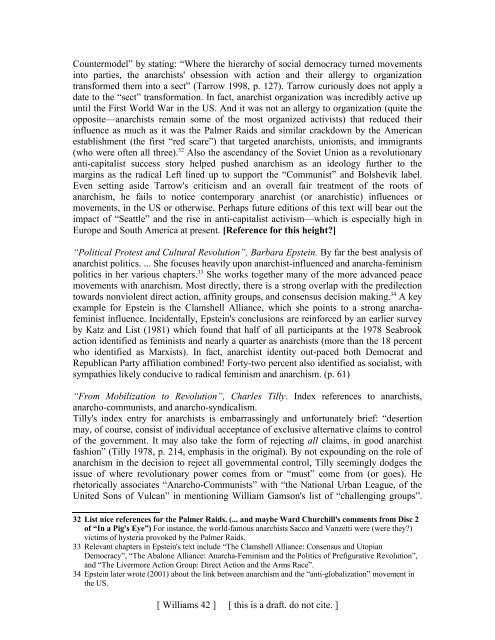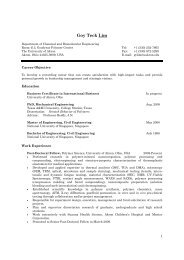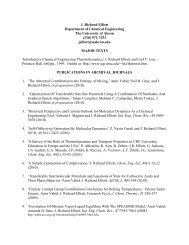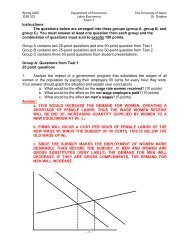Sociology of the Anarchists - Gozips.uakron.edu - The University of ...
Sociology of the Anarchists - Gozips.uakron.edu - The University of ...
Sociology of the Anarchists - Gozips.uakron.edu - The University of ...
You also want an ePaper? Increase the reach of your titles
YUMPU automatically turns print PDFs into web optimized ePapers that Google loves.
Countermodel” by stating: “Where <strong>the</strong> hierarchy <strong>of</strong> social democracy turned movements<br />
into parties, <strong>the</strong> anarchists' obsession with action and <strong>the</strong>ir allergy to organization<br />
transformed <strong>the</strong>m into a sect” (Tarrow 1998, p. 127). Tarrow curiously does not apply a<br />
date to <strong>the</strong> “sect” transformation. In fact, anarchist organization was incredibly active up<br />
until <strong>the</strong> First World War in <strong>the</strong> US. And it was not an allergy to organization (quite <strong>the</strong><br />
opposite—anarchists remain some <strong>of</strong> <strong>the</strong> most organized activists) that r<strong>edu</strong>ced <strong>the</strong>ir<br />
influence as much as it was <strong>the</strong> Palmer Raids and similar crackdown by <strong>the</strong> American<br />
establishment (<strong>the</strong> first “red scare”) that targeted anarchists, unionists, and immigrants<br />
(who were <strong>of</strong>ten all three). 32 Also <strong>the</strong> ascendancy <strong>of</strong> <strong>the</strong> Soviet Union as a revolutionary<br />
anti-capitalist success story helped pushed anarchism as an ideology fur<strong>the</strong>r to <strong>the</strong><br />
margins as <strong>the</strong> radical Left lined up to support <strong>the</strong> “Communist” and Bolshevik label.<br />
Even setting aside Tarrow's criticism and an overall fair treatment <strong>of</strong> <strong>the</strong> roots <strong>of</strong><br />
anarchism, he fails to notice contemporary anarchist (or anarchistic) influences or<br />
movements, in <strong>the</strong> US or o<strong>the</strong>rwise. Perhaps future editions <strong>of</strong> this text will bear out <strong>the</strong><br />
impact <strong>of</strong> “Seattle” and <strong>the</strong> rise in anti-capitalist activism—which is especially high in<br />
Europe and South America at present. [Reference for this height?]<br />
“Political Protest and Cultural Revolution”, Barbara Epstein. By far <strong>the</strong> best analysis <strong>of</strong><br />
anarchist politics. ... She focuses heavily upon anarchist-influenced and anarcha-feminism<br />
politics in her various chapters. 33 She works toge<strong>the</strong>r many <strong>of</strong> <strong>the</strong> more advanced peace<br />
movements with anarchism. Most directly, <strong>the</strong>re is a strong overlap with <strong>the</strong> predilection<br />
towards nonviolent direct action, affinity groups, and consensus decision making. 34 A key<br />
example for Epstein is <strong>the</strong> Clamshell Alliance, which she points to a strong anarchafeminist<br />
influence. Incidentally, Epstein's conclusions are reinforced by an earlier survey<br />
by Katz and List (1981) which found that half <strong>of</strong> all participants at <strong>the</strong> 1978 Seabrook<br />
action identified as feminists and nearly a quarter as anarchists (more than <strong>the</strong> 18 percent<br />
who identified as Marxists). In fact, anarchist identity out-paced both Democrat and<br />
Republican Party affiliation combined! Forty-two percent also identified as socialist, with<br />
sympathies likely conducive to radical feminism and anarchism. (p. 61)<br />
“From Mobilization to Revolution”, Charles Tilly. Index references to anarchists,<br />
anarcho-communists, and anarcho-syndicalism.<br />
Tilly's index entry for anarchists is embarrassingly and unfortunately brief: “desertion<br />
may, <strong>of</strong> course, consist <strong>of</strong> individual acceptance <strong>of</strong> exclusive alternative claims to control<br />
<strong>of</strong> <strong>the</strong> government. It may also take <strong>the</strong> form <strong>of</strong> rejecting all claims, in good anarchist<br />
fashion” (Tilly 1978, p. 214, emphasis in <strong>the</strong> original). By not expounding on <strong>the</strong> role <strong>of</strong><br />
anarchism in <strong>the</strong> decision to reject all governmental control, Tilly seemingly dodges <strong>the</strong><br />
issue <strong>of</strong> where revolutionary power comes from or “must” come from (or goes). He<br />
rhetorically associates “Anarcho-Communists” with “<strong>the</strong> National Urban League, <strong>of</strong> <strong>the</strong><br />
United Sons <strong>of</strong> Vulcan” in mentioning William Gamson's list <strong>of</strong> “challenging groups”.<br />
32 List nice references for <strong>the</strong> Palmer Raids. (... and maybe Ward Churchill's comments from Disc 2<br />
<strong>of</strong> “In a Pig's Eye”) For instance, <strong>the</strong> world-famous anarchists Sacco and Vanzetti were (were <strong>the</strong>y?)<br />
victims <strong>of</strong> hysteria provoked by <strong>the</strong> Palmer Raids.<br />
33 Relevant chapters in Epstein's text include “<strong>The</strong> Clamshell Alliance: Consensus and Utopian<br />
Democracy”, “<strong>The</strong> Abalone Alliance: Anarcha-Feminism and <strong>the</strong> Politics <strong>of</strong> Prefigurative Revolution”,<br />
and “<strong>The</strong> Livermore Action Group: Direct Action and <strong>the</strong> Arms Race”.<br />
34 Epstein later wrote (2001) about <strong>the</strong> link between anarchism and <strong>the</strong> “anti-globalization” movement in<br />
<strong>the</strong> US.<br />
[ Williams 42 ] [ this is a draft. do not cite. ]






